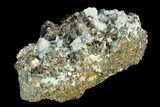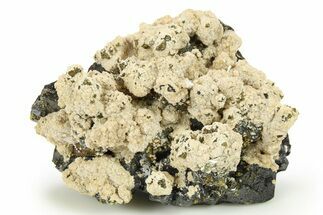This Specimen has been sold.
2.7" Cubic Pyrite and Chrysocolla Association - Peru
This is beautiful cluster of gleaming cubic pyrite crystals that formed in association with blue-green chrysocolla. It comes from the Huanzala Mine in Peru and the entire specimen measures 2.7" wide.
About Pyrite
The mineral pyrite, also known as iron pyrite, is commonly referred to as Fool's Gold because its metallic luster and pale brass-yellow hue give it a superficial resemblance to gold. In the old mining days, pyrite was sometimes mistaken for gold.
It is the most common of the sulfide minerals with the chemical formula FeS2. Pyrite crystals occur in many shapes and habits, including cubes of all sizes, penetration twin cubes, pyritohedral clusters and as small druzy crystals that can exhibit a beautiful glistening effect.
The mineral pyrite, also known as iron pyrite, is commonly referred to as Fool's Gold because its metallic luster and pale brass-yellow hue give it a superficial resemblance to gold. In the old mining days, pyrite was sometimes mistaken for gold.
It is the most common of the sulfide minerals with the chemical formula FeS2. Pyrite crystals occur in many shapes and habits, including cubes of all sizes, penetration twin cubes, pyritohedral clusters and as small druzy crystals that can exhibit a beautiful glistening effect.
Chrysocolla is a basic copper silicate that typically forms as a pseudomorph following other copper based minerals. The chemical formula is considered undetermined due to the varying substitutions of elements and water content in its chemical structure. However, there is a form of chrysocolla with an identifiable chemical formula of Cu2H2Si2O5(OH)4 that can be found in microcrystals.
Regularly, chrysocolla will form as botryoidal lumps and spheres, rarely forming visible crystals. It can also form in both solid and fibrous veins, over fibrous minerals, and in crusts. Known for its sharp and vibrant coloring, chrysocolla can display a wide variety of colors such as bluish-green, bright green, light blue, to even sometimes multicolored specimens depending on the atmosphere present during formation.
Regularly, chrysocolla will form as botryoidal lumps and spheres, rarely forming visible crystals. It can also form in both solid and fibrous veins, over fibrous minerals, and in crusts. Known for its sharp and vibrant coloring, chrysocolla can display a wide variety of colors such as bluish-green, bright green, light blue, to even sometimes multicolored specimens depending on the atmosphere present during formation.
SPECIES
Pyrite & Chrysocolla
LOCATION
Huanzala Mine, Bolognesi, Peru
SIZE
2.7" wide
CATEGORY
SUB CATEGORY
ITEM
#126582
 Reviews
Reviews













